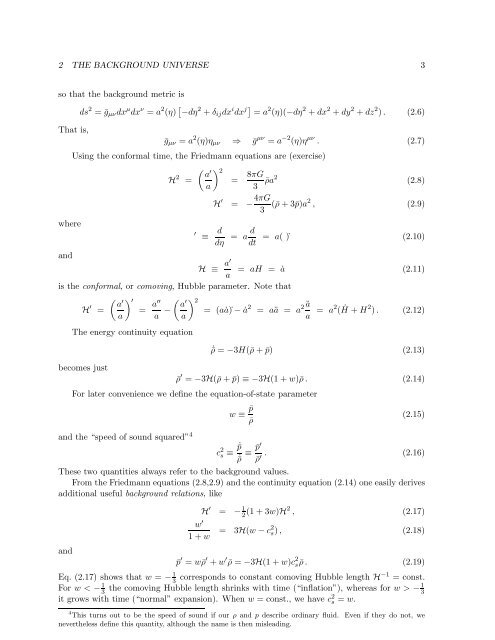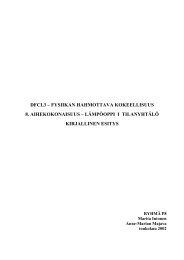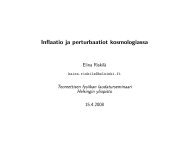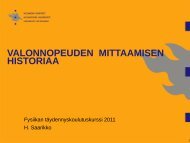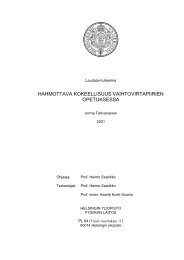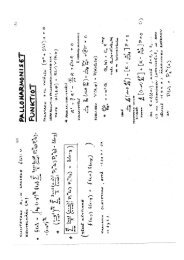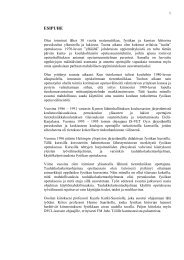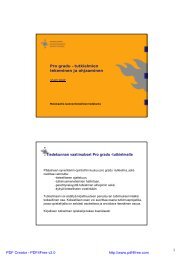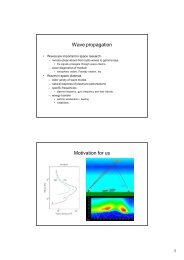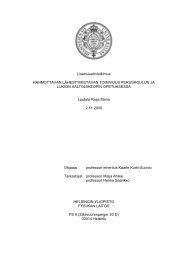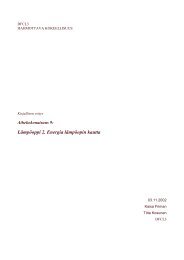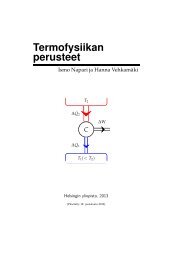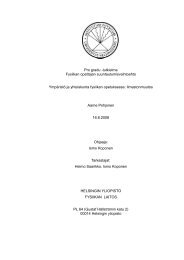2 THE BACKGROUND UNIVERSE 2all close to each other, for the perturbed spacetime, for which (1.1) holds. The choice amongthese coordinate systems is called the gauge choice, to be discussed a little later.In first-order (or linear) perturbation theory, we drop all terms from our equations whichcontain products of the small quantities δg µν , δg µν,ρ and δg µν,ρσ . The field equation (1.5)becomes then a linear differential equation for δg µν , making things much easier than in full GR.In second-order perturbation theory, one keeps also those terms with a product of two (but nomore) small quantities. In these lectures we only discuss first-order perturbation theory.The simplest case is the one where the background is the Minkowski space. Then ḡ µν = η µν ,and Ḡµ ν = ¯T µ ν = 0.In cosmological perturbation theory the background spacetime is the Friedmann–Robertson–Walker universe. Now the background spacetime is curved, and is not empty. While it ishomogeneous and isotropic, it is time-dependent. In these lectures we shall only consider thecase where the background is the flat FRW universe. This case is much simpler than the openand closed ones 3 , since now the t = const time slices (“space at time t”) have Euclidean geometry.This will allow us to do 3-dimensional Fourier-transformations in space.The separation into the background and perturbation is always done so that the spatialaverage of the perturbation is zero, i.e., the background value (at time t) is the spatial averageof the full quantity over the time slice t = const.2 The Background UniverseOur background spacetime is the flat Friedmann–Robertson–Walker universe FRW(0). Thebackground metric in comoving coordinates (t,x,y,z) isds 2 = ḡ µν dx µ dx ν = −dt 2 + a 2 (t)δ ij dx i dx j = −dt 2 + a 2 (t)(dx 2 + dy 2 + dz 2 ), (2.1)where a(t) is the scale factor, to be solved from the (flat universe) Friedmann equations,H 2 =where H ≡ ȧ/a is the Hubble parameter,(ȧ ) 2= 8πG ¯ρ (2.2)a 3äa= −4πG (¯ρ + 3¯p) (2.3)3· ≡ d dt ,and the ¯ρ and ¯p are the homogeneous background energy density and pressure. Another <strong>version</strong>of the second Friedmann equation isḢ ≡ ä (ȧ ) 2a − = −4πG(¯ρ + ¯p). (2.4)abyWe shall find it more convenient to use as a time coordinate the conformal time η, defineddη = dta(t)(2.5)3 For cosmological perturbation theory for open or closed FRW universe, see e.g. Mukhanov, Feldman, Brandenberger,Phys. Rep. 215, 203 (1992).
2 THE BACKGROUND UNIVERSE 3so that the background metric isThat is,whereandds 2 = ḡ µν dx µ dx ν = a 2 (η) [ −dη 2 + δ ij dx i dx j] = a 2 (η)(−dη 2 + dx 2 + dy 2 + dz 2 ). (2.6)ḡ µν = a 2 (η)η µν ⇒ ḡ µν = a −2 (η)η µν . (2.7)Using the conformal time, the Friedmann equations are (exercise)( aH 2 ′) 2= = 8πGa 3 ¯ρa2 (2.8)H ′ = − 4πG3 (¯ρ + 3¯p)a2 , (2.9)′≡ddη = a d dt= a( )˙ (2.10)H ≡ a′= aH = ȧ (2.11)ais the conformal, or comoving, Hubble parameter. Note that( aH ′ ′) ′ (= = a′′ a′) 2a a − = (aȧ)˙− ȧ 2 = aä = a 2äaa = a2 (Ḣ + H2 ). (2.12)The energy continuity equationbecomes just˙¯ρ = −3H(¯ρ + ¯p) (2.13)¯ρ ′ = −3H(¯ρ + ¯p) ≡ −3H(1 + w)¯ρ . (2.14)For later convenience we define the equation-of-state parameterw ≡ ¯p¯ρ(2.15)and the “speed of sound squared” 4c 2 s ≡ ˙¯p˙¯ρ ≡ ¯p′¯ρ ′ . (2.16)These two quantities always refer to the background values.From the Friedmann equations (2.8,2.9) and the continuity equation (2.14) one easily derivesadditional useful background relations, likeandH ′ = − 1 2 (1 + 3w)H2 , (2.17)w ′1 + w = 3H(w − c2 s), (2.18)¯p ′ = w¯ρ ′ + w ′¯ρ = −3H(1 + w)c 2 s ¯ρ. (2.19)Eq. (2.17) shows that w = − 1 3 corresponds to constant comoving Hubble length H−1 = const.For w < − 1 3 the comoving Hubble length shrinks with time (“inflation”), whereas for w > −1 3it grows with time (“normal” expansion). When w = const., we have c 2 s = w.4 This turns out to be the speed of sound if our ρ and p describe ordinary fluid. Even if they do not, wenevertheless define this quantity, although the name is then misleading.


